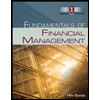
Stock options; graded vesting; measurement using a single fair value per option
• LO19–2
Refer to the situation described in P 19–2. Assume Pastner measures the fair value of all options on January 1, 2018, to be $4.50 per option using a single weighted-average expected life of the options assumption.
Required:
1. Determine the compensation expense related to the options to be recorded each year 2018–2021, assuming Pastner allocates the compensation cost for each of the four groups (tranches) separately.
2. Determine the compensation expense related to the options to be recorded each year 2018–2021, assuming Pastner uses the straight-line method to allocate the total compensation cost.
P 19–2
Stock options; graded vesting
• LO19–2
January 1, 2018, the company issued 400,000 executive stock options permitting executives to buy 400,000 shares of Pastner stock for $34 per share. One-fourth of the options vest in each of the next four years beginning at December 31, 2018 (graded vesting). Pastner elects to separate the total award into four groups (or tranches) according to the year in which they vest and measures the compensation cost for each vesting date as a separate award. The fair value of each tranche is estimated at January 1, 2018, as follows:
| Vesting Date | Amount Vesting Fair | Value per Option |
| Dec. 31, 2018 | 25% | $3.50 |
| Dec. 31, 2019 | 25% | $4.00 |
| Dec. 31, 2020 | 25% | $4.50 |
| Dec. 31, 2021 | 25% | $5.00 |
Required:
1. Determine the compensation expense related to the options to be recorded each year 2018–2021, assuming Pastner allocates the compensation cost for each of the four groups (tranches) separately.
2. Determine the compensation expense related to the options to be recorded each year 2018–2021, assuming Pastner uses the straight-line method to allocate the total compensation cost.
Want to see the full answer?
Check out a sample textbook solution
Chapter 19 Solutions
INTERMEDIATE ACTG+CONNECT <LOOSE>
- You invest 60% of your money in Asset A (expected return = 8%, standard deviation = 12%) and 40% in Asset B (expected return = 5%, standard deviation = 8%). The correlation coefficient between the two assets is 0.3. What is the expected return and standard deviation of the portfolio?correct solutarrow_forwardYou invest 60% of your money in Asset A (expected return = 8%, standard deviation = 12%) and 40% in Asset B (expected return = 5%, standard deviation = 8%). The correlation coefficient between the two assets is 0.3. What is the expected return and standard deviation of the portfolio?need jelparrow_forwardI mistakenly submitted blurr image please comment i will write values. please dont Solve with incorrect values otherwise unhelpful.no aiarrow_forward
- 1) Identify whethere the company is paying out dividends based on the attached statement. 2) Describe in detail how that the company’s dividend payouts have changed over the past five years. 3)Describe in detail the changes in “total equity” (representing the current “book value” of the company).arrow_forwardWhich is not an objective of internal controls?A. Safeguard assetsB. Improve profitsC. Ensure accurate recordsD. Promote operational efficiencyneed helparrow_forwardWhich is not an objective of internal controls?A. Safeguard assetsB. Improve profitsC. Ensure accurate recordsD. Promote operational efficiencyno aiarrow_forward
- Can you solve this general accounting problem using appropriate accounting principles?arrow_forwardWhich is not an objective of internal controls?A. Safeguard assetsB. Improve profitsC. Ensure accurate recordsD. Promote operational efficiency no aiarrow_forwardPlease provide the accurate answer to this financial accounting problem using appropriate methods.arrow_forward
 Fundamentals of Financial Management (MindTap Cou...FinanceISBN:9781285867977Author:Eugene F. Brigham, Joel F. HoustonPublisher:Cengage Learning
Fundamentals of Financial Management (MindTap Cou...FinanceISBN:9781285867977Author:Eugene F. Brigham, Joel F. HoustonPublisher:Cengage Learning
